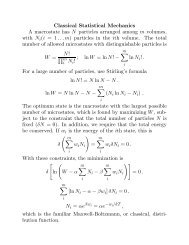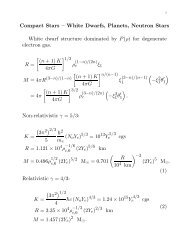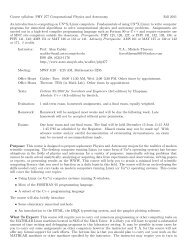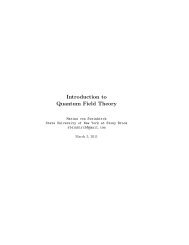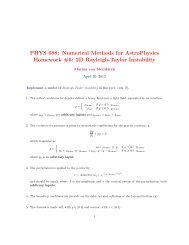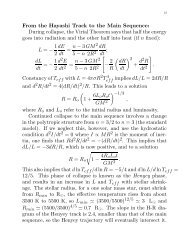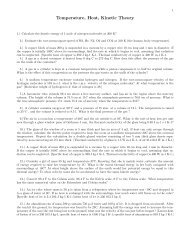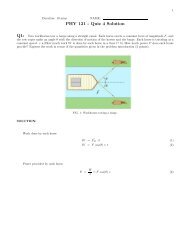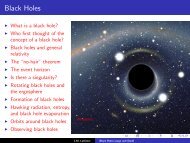sample research paper - Stony Brook Astronomy
sample research paper - Stony Brook Astronomy
sample research paper - Stony Brook Astronomy
Create successful ePaper yourself
Turn your PDF publications into a flip-book with our unique Google optimized e-Paper software.
– 8 –<br />
to have a mass of order r∆v 2 /G where r is their radii, but this mass is several orders of<br />
magnitude larger than observed. These results indicate the clouds are not an equilibrium<br />
population. The clouds must be either pressure-confined or transitory. In the absence of<br />
pressure information, it is unknown if they are pressure-confined. Unless there is some<br />
sort of confinement, however, their lifetimes must be significantly less than their thermal<br />
evaporation timescale, about 100 Myr (Stanimirović et al. 2006), or their internal dynamical<br />
timescale, r/∆v ∼ 3 Myr.<br />
The standard explanation for the existence of disc-halo clouds is that they are formed<br />
by the cooling and condensing of hot gas that has been expelled from the disc which then<br />
falls back to the plane (Shapiro & Field 1976; Bregman 1980). However, the hot gas is<br />
expected to be fairly uniform in the halo so this model cannot account for the observed<br />
QI-QIV asymmetries.<br />
Ford et al. (2010) instead proposes that the disc-halo clouds are related to areas of<br />
star formation and result from stellar feedback and superbubbles that have swept gas into<br />
the halo. The clouds are formed in the lower halo. The scale height differences could<br />
be accounted for by the greater star formation rate and number of superbubbles in QI as<br />
compared with QIV. But the time delay between the specific events producting superbubbles<br />
and cloud formation means that there should be no direct correlation with other detailes of<br />
star formation in the disc, as observed.<br />
The sheer number of clouds detected means that these clouds are a major component<br />
of the Galaxy. Their concentration toward the Galactic plane and tight coupling to Galactic<br />
rotation and spiral structure preclude the possibility that they are created through tidal<br />
stripping of satellite dwarf galaxies or infalling primordial gas. These clouds play an important<br />
role in Galaxy evolution and the exchange of gas between the disc and halo. They are<br />
likely common in external galaxies but will be extremely difficult to detect there for many<br />
years.<br />
REFERENCES<br />
Benjamin, R. A. et al. 2003, PASP 115, 953.<br />
Bregman, J. N. 1980, ApJ 236, 577.<br />
Clemens, D. P. 1985, ApJ 295, 422.<br />
Dickey, J. M. & Lockman, F. J. 1990, ARA& A 28, 215.



